Musician for musicians
BMC’s activities are extremely diverse: operating the Hungarian Music Information Database and Library, working as a record company, and organizing and managing events. The growing Music Library today houses tens of thousands of copies and contains up- to-date information on a century’s worth of Hungarian composers and their work.
Designed by Art1st Design Studio Kft. using Archicad, the Music Center is located in a newly emerging cultural district of Budapest. Although a large part of the premises are open to the public, private resources financed most of the transformation of the 120 year- old building, and one can sense in every part of it that the BMC was built by a musician for musicians. The original building was a one-story residential building with shops facing the street on the ground floor, built in 1890 in the neoclassical style of the 19th century. Close to 10 years of hard work went into preparing, designing and implementing the design of the building. This effort had a large impact on the interior design: it had to reflect the immense personal achievement of creating this institution in the midst of an economic crisis. In order to do so, the design solutions had to be simple, straightforward, and functional at the same time, while maintaining a handcrafted detail. This was the
background that finally made the house likeable, tangible, welcoming, and comfortable despite its scale and functionality.
Archicad contributed to keeping the costs low and the schedule on time. For example, as there were more than 150 different variations of doors in the building, the automatically-generated door list saved a significant amount of time for the architects. Archicad’s Teamwork function was also the key for the team to work efficiently. Communications with the client during the early stages of the project using 3D models rendered in Artlantis led to a better understanding of the design.

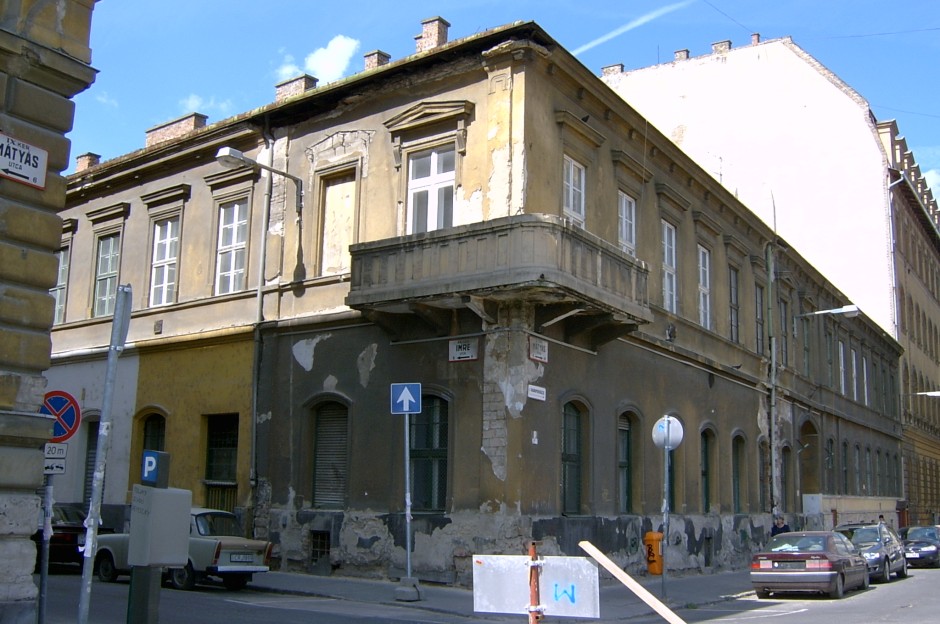

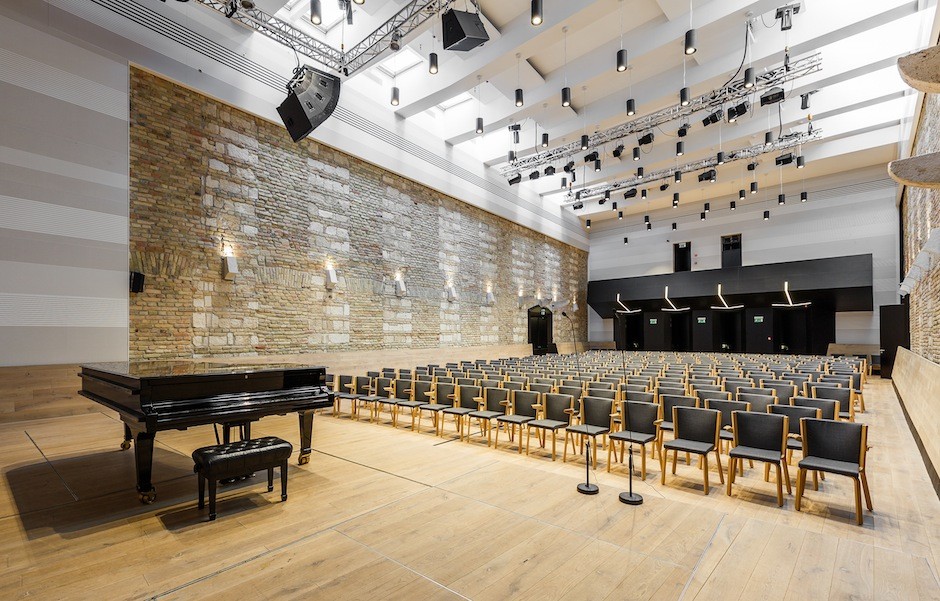
The Concert Hall
As BMC is home to a wide range of activities, the building itself has numerous functions and is able to serve multiple purposes. The ground floor houses the main public functions, such as the Jazz Club — a restaurant and coffee house — and the nearly 300 m2 (3,230 square feet) Concert Hall. The Concert Hall is located in the former inner courtyard, and is connected to the street through a large Lobby running along both sides of the building. Natural light enters the Hall through a double row of skylights, reducing the use of artificial lighting and evoking the atmosphere of the former courtyard. The exposed original brick walls provide the Concert Hall with a unique character not only visually, but also acoustically, due to their irregular surfaces and acoustic mass; as an added bonus, this solution helped keep construction costs at a minimum. The concert hall’s balcony is cantilevered above the four entrances, placed in the original openings of the wall. On the sides, the wooden oak flooring is curved along the edges, making the room feel as if it were floating, almost like a ship.
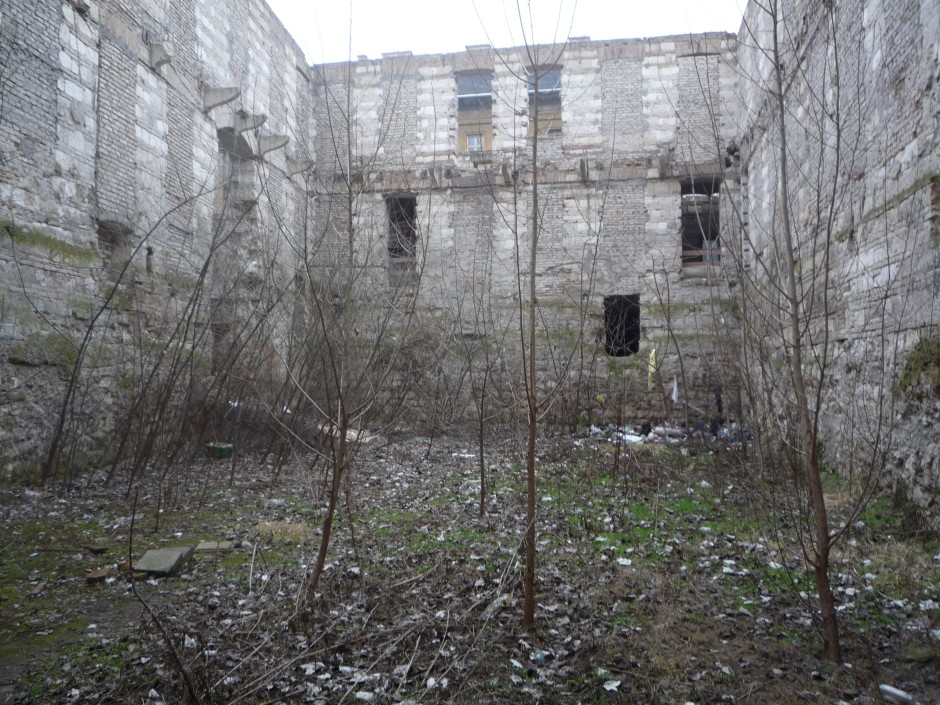
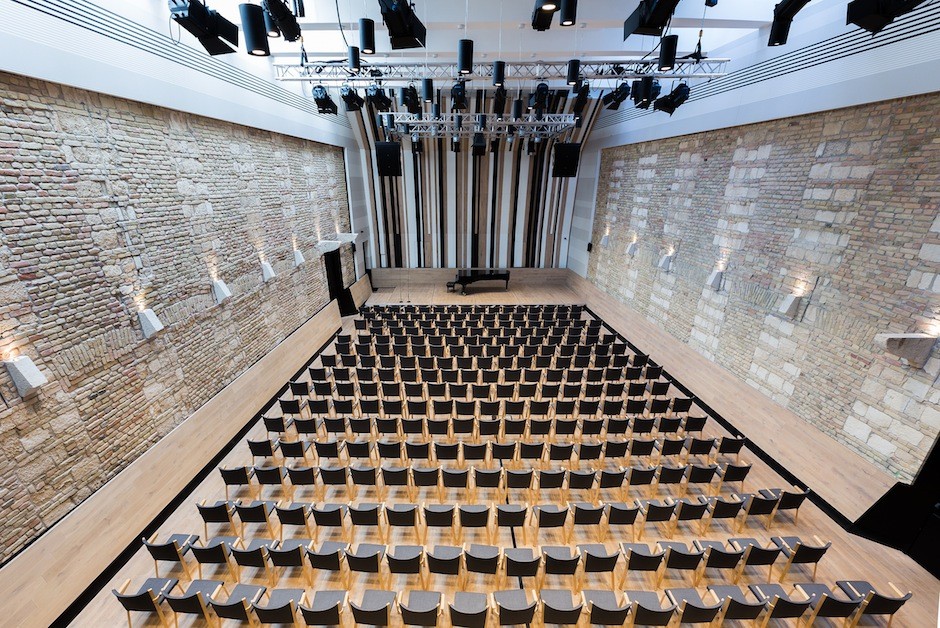
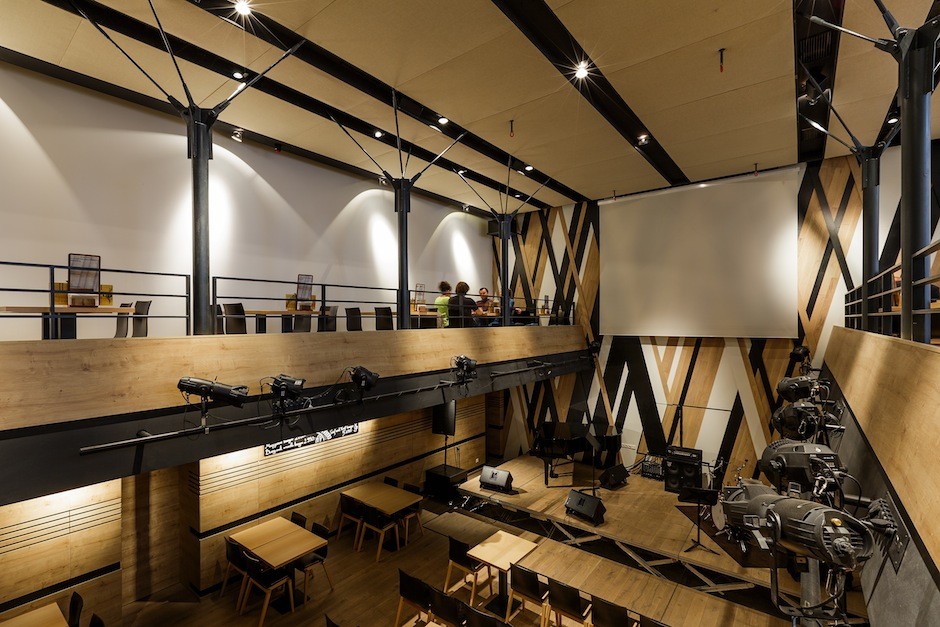
Jazz Club
The two-story jazz club is located on the street side. The atrium in the middle of the space enables the spectators to view and enjoy the concerts from both levels. The ground floor slab is suspended by six steel elements to the beams above. These give a light and playful division to the space; evoke the former hanging corridors of the courtyard, and by replacing the
otherwise necessary supporting columns they ensure that nothing interferes with visibility on the basement level. The interior design of the club was based on the use of simple, natural materials. Acoustically, it is completely separated from the Concert Hall, so that the two spaces can function simultaneously, without interfering with each other.
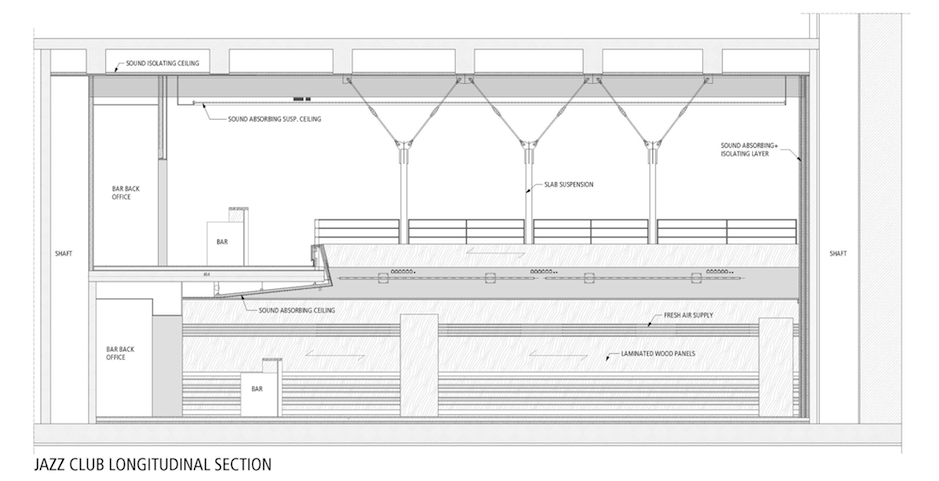
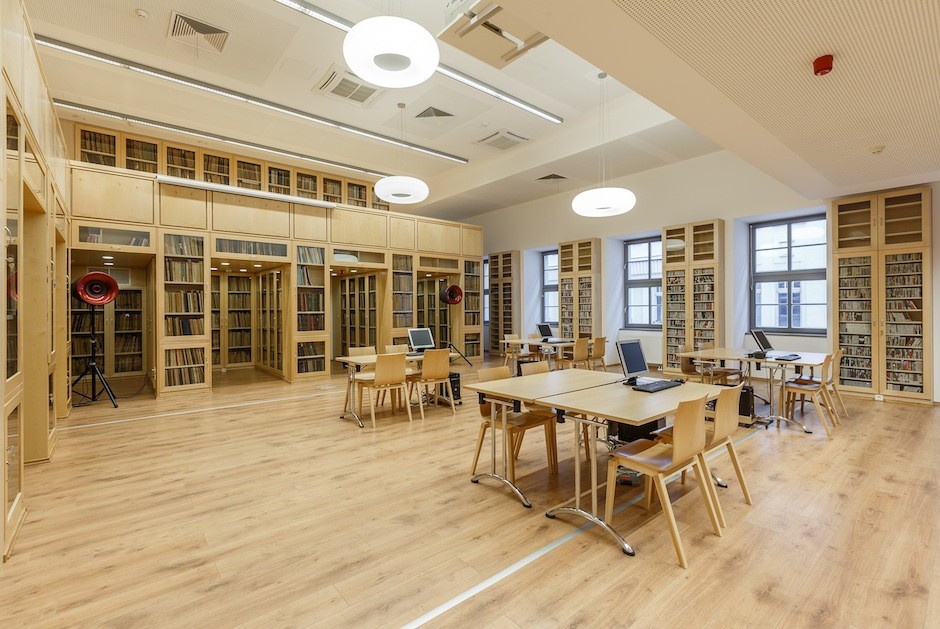
Library and recording studios
The first floor is the new home of the BMC offices; it also houses the Recording Studios, the Music Information Database and Library, and the International Péter Eötvös Institute. The Library is a very simple and functional space, with its 7 meter (23 feet) height and its cozy mezzanine. The recording studios in the rear wing are connected to rooms on both the ground floor and the first floor as well as to the rehearsal room in the basement and the concert hall. This way, music can be recorded simultaneously from up to seven different locations in the building in the highest quality.
The Corner Conference Room
Small guestrooms are located in the attic, which will house students participating in workshops held in the building, partially organized by the Péter Eötvös Institute. The same level houses the spatially most distorted room of the building, the Corner Conference Room, a venue for smaller events.
Due to its location at the meeting point of the two facades, the roof, and the corner element, none of its sides are parallel or perpendicular to each other, and only the floor is horizontal. In order to emphasize the distorted nature of the space, all surfaces are covered with oak.
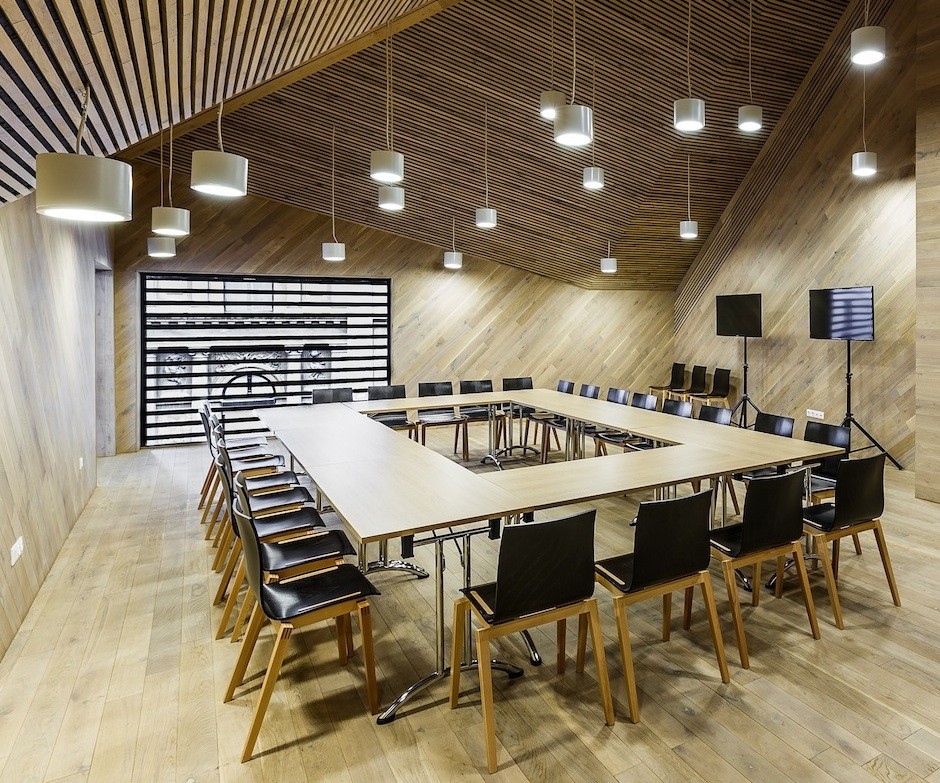
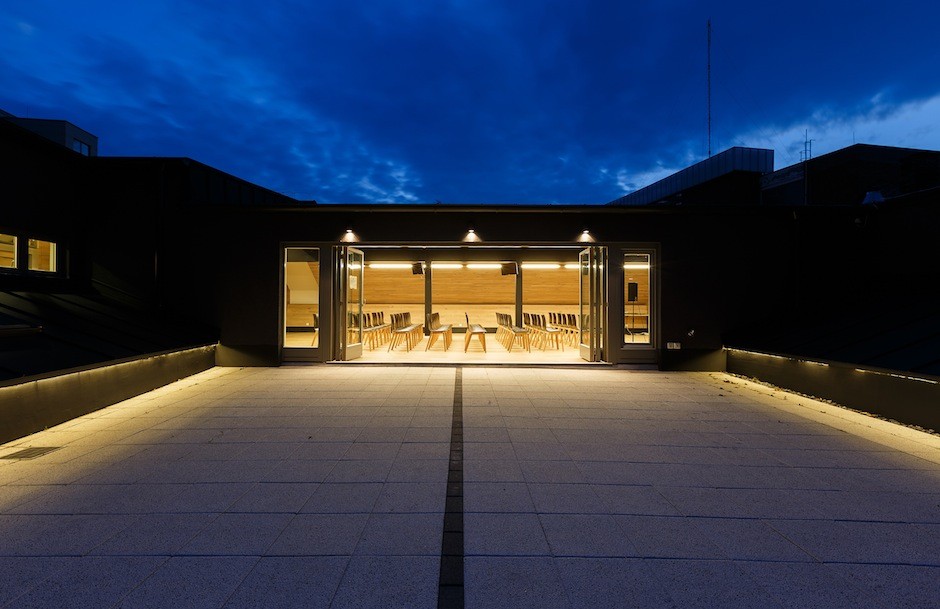
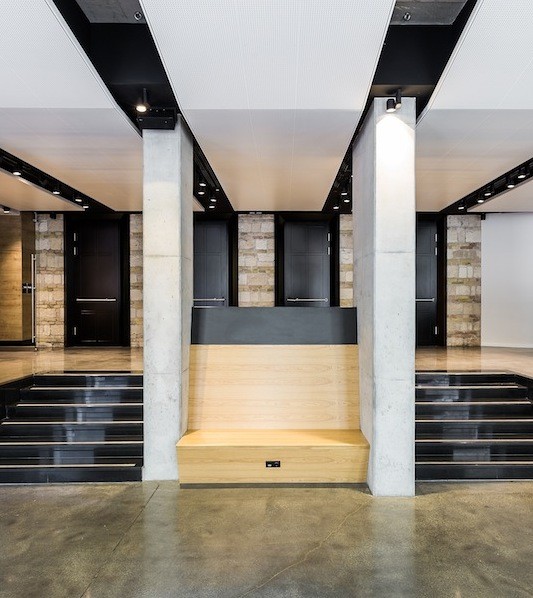
Interior
The slab covering the Concert Hall serves also as a roof terrace, which can be accessed through the Event Hall, located in the upper part of the attic and connected to the terrace by a large retractable door. For the interior surfaces, the designers chose pure, natural materials. Black, white, gray and oak dominate, accompanied in many places by the friendly, warm surface of the visible brick walls, which beg to be touched. The lobby and other main public areas are designed with polished concrete flooring. “Our intent was to mark the complete transformation of the building’s function both on the inside and on the elevations,” said Dániel Taraczky, architect. Due to their simple and clean proportions, the original elevations were conserved and fully refurbished. Although it’s not a listed building, its proportional mass fits well with the surroundings. Above the main cornice, however, following the symbolism of contemporary
music, an entirely new world begins. The building is slit on the corner, and a fragmented element breaks through the thick, old walls. At the bottom, the paneling of the corner element is interrupted, opening the way towards the interior of the building.
The main entrance is recessed towards the building’s interior, creating a covered external lobby under the canopy of the first floor. The installation of large glazed surfaces emphasizes the transformation from dwelling to public building, and enables a complete transparency when entering the building on the corner.
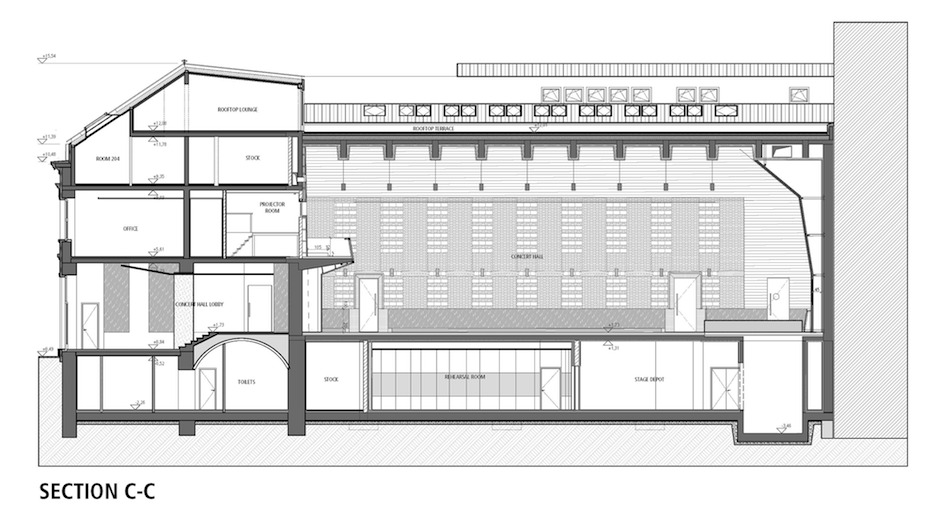
The corner
The metallic panels of the corner element gradually become horizontal from vertical, changing in both length and inclination as we move from the street level towards the roof. Thus, the paneling of the ground level is transformed to a shading element on the upper levels, revealing the window distribution of the original facade when lit from behind at night.
The gradual closure of the corner element towards the roof reflects the internal organization of the building, which allows a more delicate connection with the world of music on the upper levels. The corner became a focus point for several reasons.
This is the only part of the building that is visible from the Buda side of Budapest, and it was the most important point of the original residential building as well. One could see the Danube from the former corner balcony, and it belonged to the apartment that was the largest and most luxurious of them all. In order to keep this focus, the importance of the corner had to be emphasized on the functional level of the new building as well. Therefore, the main public entrance of the building was shifted from its original place to the street corner, and the upper levels also house priority areas. The use of sections is fundamental when designing such complicated spaces, and the architects benefited from Archicad’s ability to provide quick sections throughout the design process.

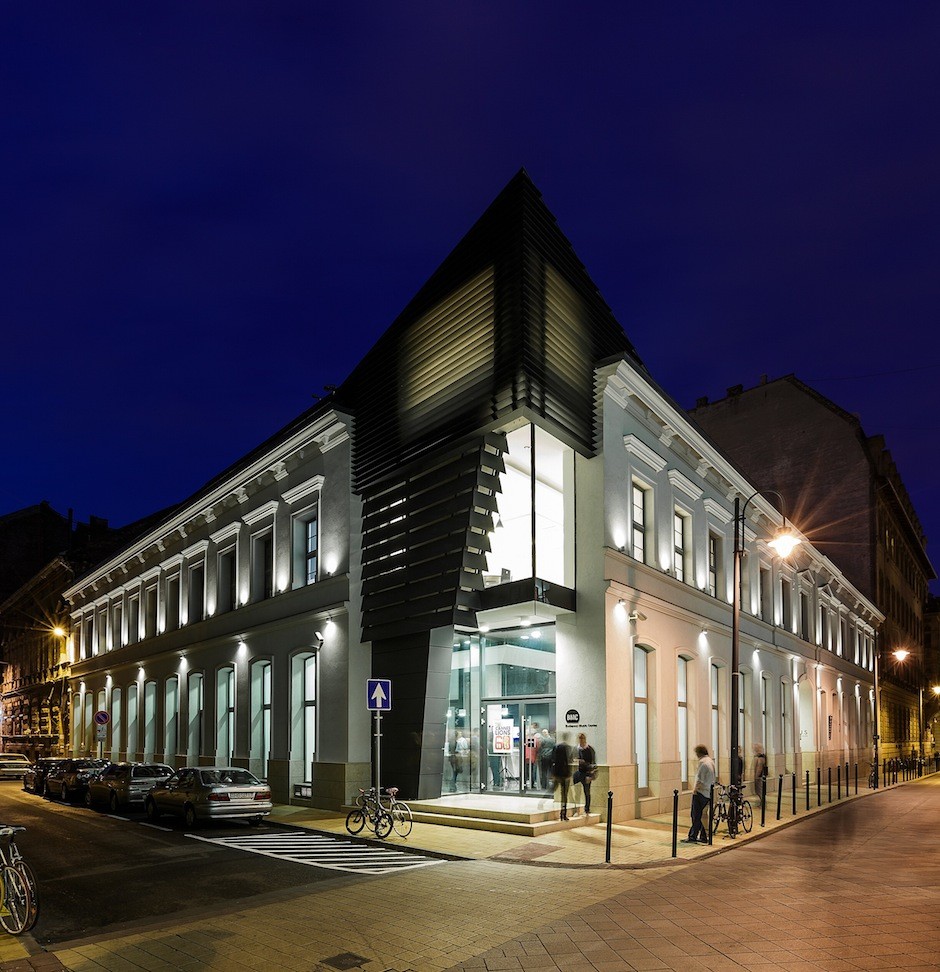
The future of BMC
László Gőz has made provisions for the future of the building. He has penned a written statement for future heirs, forbidding them to change the content or the function of the Budapest Music Center, to sell or to transform the building. As it is a private and independent institution, the leadership will invariably change, but the rules bequeathed will always be respected.
Art1st Design Studio
www.art1st.hu
The studio was established in 1989 and it has grown from a graphic design studio into a full service design company in Hungary. The architecture and interior design skill was later introduced to the firm. Because of their strong creative design background, they have been very successful with retail design projects. Currently there are 25 employees and deals with over 250 projects per year.
About Graphisoft
Graphisoft® ignited the BIM revolution in 1984 with Archicad®, the industry first BIM software for architects. Graphisoft continues to lead the industry with innovative solutions such as its revolutionary BIMcloud®, the world’s first real-time BIM collaboration environment; and BIMx®, the world’s leading mobile app for lightweight access to BIM for non-professionals. Graphisoft is part of the Nemetschek Group.
